Market dynamics are changing. The shift to electrification is slowing down. Forecasting and planning have become more complex than ever. With that, profitability continues to be a key challenge facing OEMs and distributors alike. Thus, it has become essential to increase one’s control over those market dynamics. Price, the most direct lever of them all, presents an emerging solution to this issue. Driving the need for direct and more advanced pricing mechanisms.
Fluctuating car demand, though common for manufacturers, has intensified in recent years. First, global supply chain disruptions caused by the COVID-19 pandemic left manufacturers unable to meet demand. The industry was slow to respond adequately to the situation — while manufacturers were often prioritizing more expensive models and sometimes even stopped offering less expensive models all together, many customers still experienced record wait times. As a result, price increases were insufficient to rectify the imbalance between supply and demand, leading to significant customer reluctance in the aftermath.
Now, the market has flipped, in effect caused by rising inflation and change in political focus points. Three out of five consumers are delaying purchases because of economic concerns, as revealed in the Global Automotive Study conducted last year. Globally, manufacturers are facing weak demand, with dealer lots full and delivery times at historic lows. Entrants like Tesla and BYD, with growth ambitions, have further intensified competition. In addition, EV demand is declining while simultaneously the expanding EV portfolios sequentially start entering the markets. Meeting sales targets while ensuring profitability becomes crucial, putting pressure on manufacturers to implement AI-based advanced pricing strategies to adapt to market conditions.
Car manufacturers should consider adopting a more flexible pricing approach
In the past, dealers modified their discounts to balance out fluctuations in demand. With OEMs embracing an agency model for sales, it’s their responsibility to adjust prices accordingly. To cope with this responsibility, car manufacturers are looking into solutions outside of the automotive sector. Various sectors, from travel companies to gas stations, have successfully deployed AI-based advanced pricing to navigate through market uncertainties.
It’s no wonder that this approach needs to find its way into the automotive sector. For instance, Tesla, like some other manufacturers, has frequently adjusted the price of their vehicles. The price changes were often substantial, even though the car itself remained unchanged. The consensus among customers was negative, as new customers frequently responded with hostility to price increases.
On the flip side, existing customers were apprehensive about price decreases and how they would affect their vehicle’s resale value. Despite common assumptions, over 50% of customers in our Global Automotive Study were willing to accept more volatile price changes. What strategies can be used to effectively implement advanced pricing and better meet the evolving demands of automotive consumers?
Three key solutions for advanced pricing success
1. ML-enabled advanced pricing
The key to any successful pricing decision is a deep understanding of the price elasticities at play. Nevertheless, a product can exhibit various levels of price elasticity. Market conditions, portfolio effects, and the respective price point greatly affect the resulting volume reaction to a potential price move.
At Simon-Kucher, we recommend the use of machine learning to solve this challenge. Building upon our proven market simulation approach, we train Machine Learning models on a mix of historic and simulated data so that you can accurately forecast demand at certain price points. These forecasting tools present the ideal set-up to test out various what-if scenarios and support you with sensitivities on potential price actions.
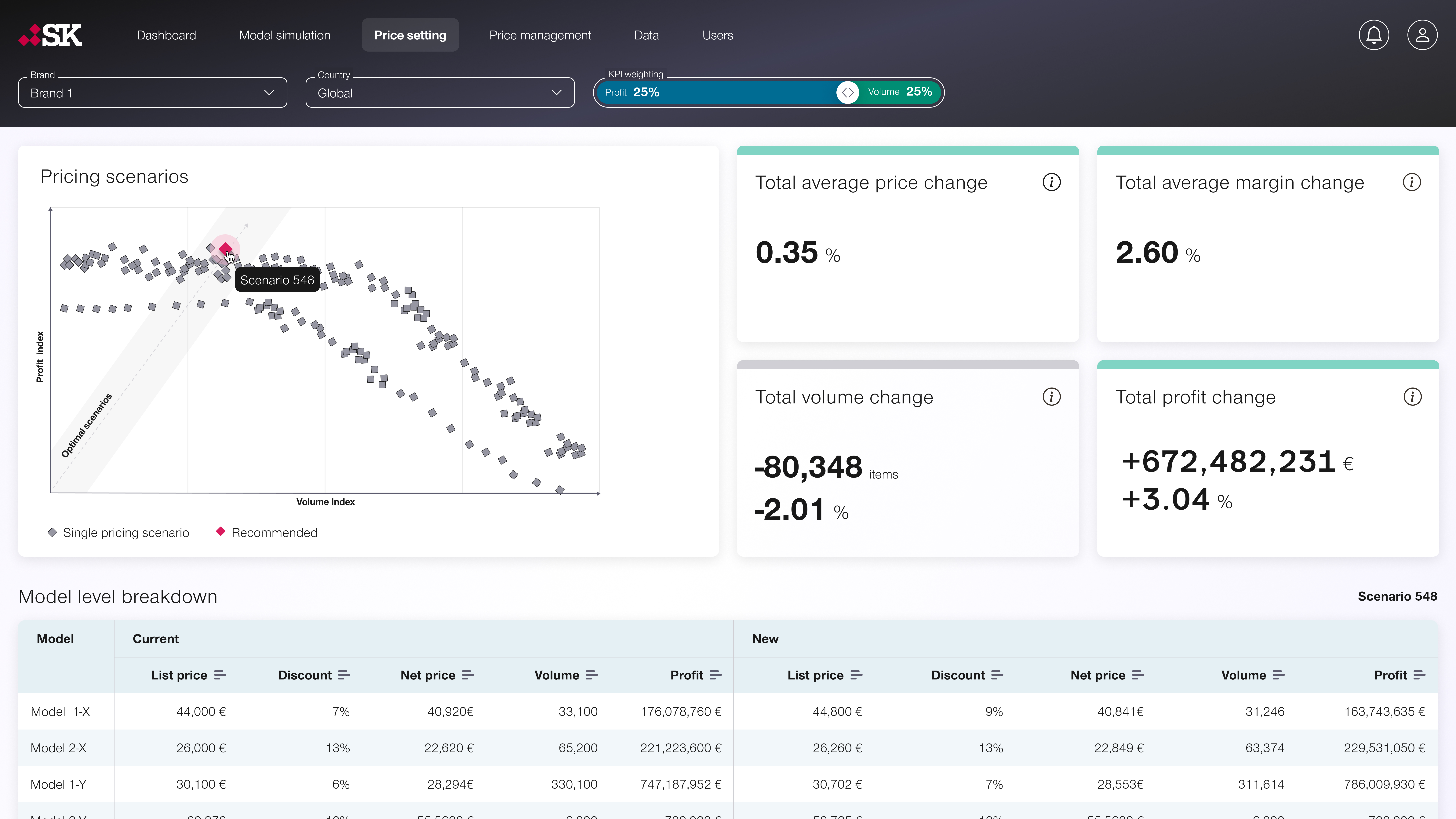
Simon-Kucher’s Pricing Performance dashboard allows you to review historical pricing as well as trends on a portfolio and model level.
Tailormade for your requirements, the ML-enabled advanced pricing solution enables you to achieve data-driven and agile automotive pricing. By using a market simulation approach, this solution simplifies the calculation of price elasticities and improves buying behavior forecasting.
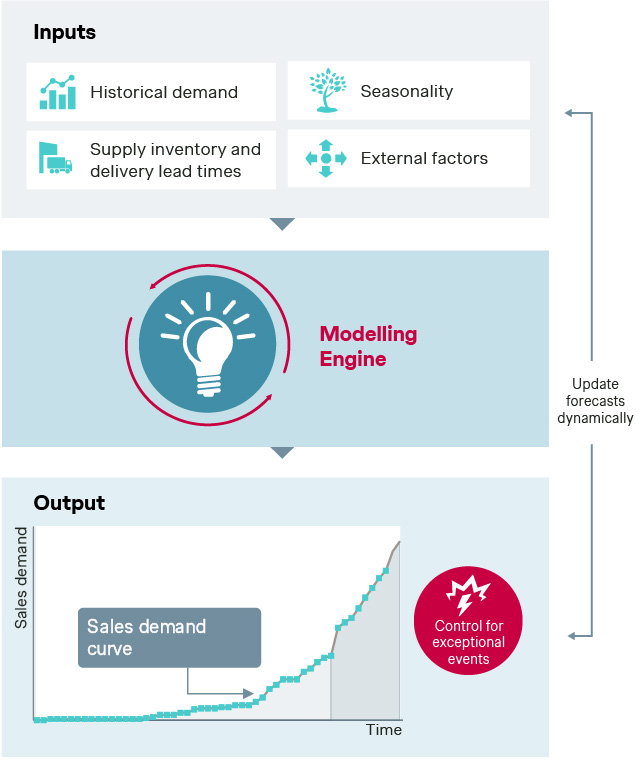
Forecasting tool: We train a machine learning model on input data to understand sales demand over time and predict demand in the future.
Moreover, with the help of a demand forecasting model, you can analyze previous transactions and estimate the influence of store location, seasonality, and other variables on demand, enabling you to forecast future outcomes.
2. Advanced discount steering
While promotions are not a novel concept in the automotive sector, our experience has shown that companies rarely tap into their complete potential. Besides the discount percentage, the success of a promotion campaign depends on factors such as the type of discount, timing of the promotion, and the product being promoted.
At Simon-Kucher, our pricing specialists in the automotive sector provide you with 360-degree optimization of central discount management and processes. Our recommendations prioritize customer needs, taking into account impact and cost, and can even be integrated with ML-driven advanced pricing.
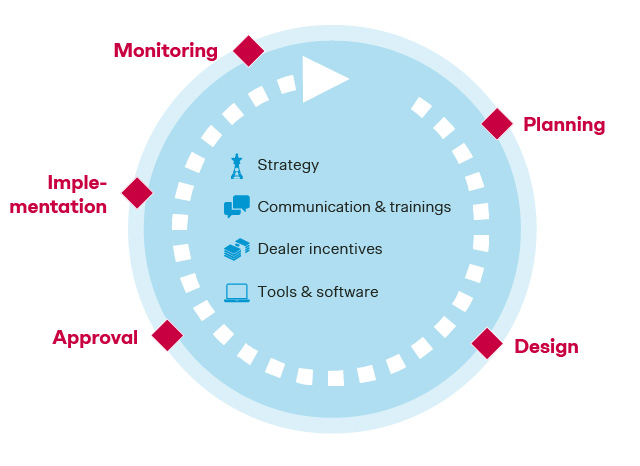
Implement an effective governance: Enforce clear internal processes to help secure and constantly improve all elements of your incentive strategy.
To implement an effective governance, you must enforce clear the following internal processes to help secure and constantly improve all elements of your incentive strategy.
Planning: Implement a targeted and flexible use of incentives. Create distinct programs for different vehicles or models.
Design: Set up consistent discount levels that achieve positive margins on all models, including low-cost ones.
Approval: Implement efficient approval process with low level of complexity and clear guidelines. Monitor them based on defined KPIs such as price elasticity and campaign effectiveness.
Implementation: Provide central guidance to your sales representatives. This includes a pragmatic list of dos and don’ts and structured manuals. Streamline active incentive programs and approval processes.
Monitoring: Evaluate your campaign’s effectiveness based on defined KPIs such as volume, revenue, and profit impact. Create statistical analyses and isolate the effect of single incentives.
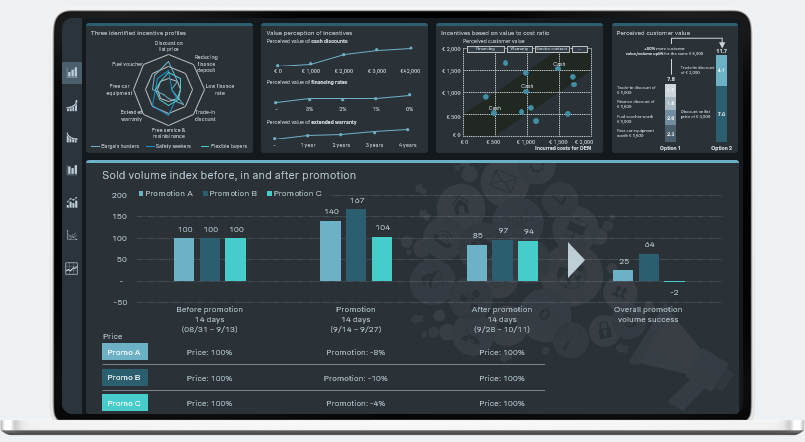
Enable consistent monitoring: Monitor the effectiveness of incentives by tracking both volume (see below) and profit impacts in the short term and the long term.
By using a promotion effectiveness analysis framework, you can optimize future promotions based on the past performance. Especially with rising tension between optimizing EV versus ICE sales, making a holistic incentive strategy essential. The following three elements are a must-have to drive promotion effectiveness:
- Insights and analysis: Understand historical promotion performance and develop hypotheses and initial opportunities.
- Promotion optimization: Optimize promotion mechanics, frequency, and depth by item through ML scenario testing.
- Strategy development: Use AI-driven insights to develop promotion strategy recommendations, forecast ROI impact, and integrate into a promotion roadmap.
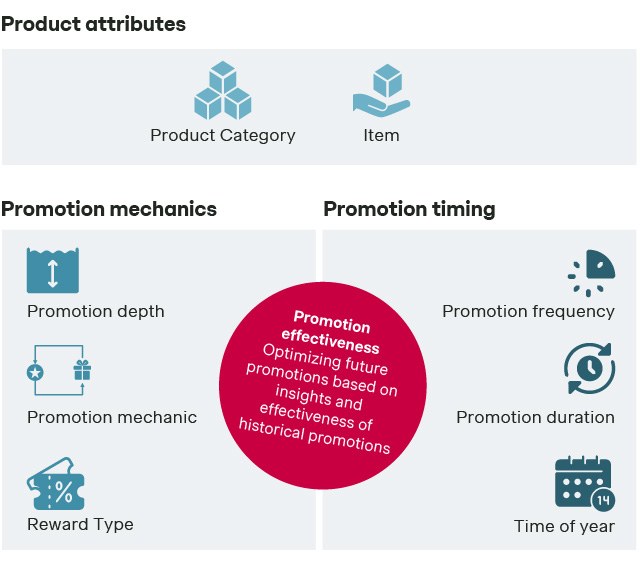
Promotion effectiveness: Optimizing future promotions based on insights and effectiveness of e.g. historical promotions.
Our solution investigates the underlying effects and facilitates a holistic promotion strategy. One step further, we boost incentive steering mechanisms by training AI on data from previous promotions. You can deploy this centralized approach as a tailored app to further support your promotion planning and monitoring for future campaigns.
3. The ultimate lever: AI-supported customer pricing
Salespeople are fighting the fight — because of poor customer specific recommendations, they often overwrite price suggestions to close deals. Optimizing market-level pricing is important, but unlocking the full potential of a transaction requires adjusting the price to a customer’s needs and willingness to pay.
When sales reps have a strong support system, they can close deals more effectively. Using AI recommendations for customer pricing optimization is crucial in enhancing existing solutions. Based upon the salesperson’s entry, you can assess factors that impact the perceived value of the products and the expected price elasticity of the customer.
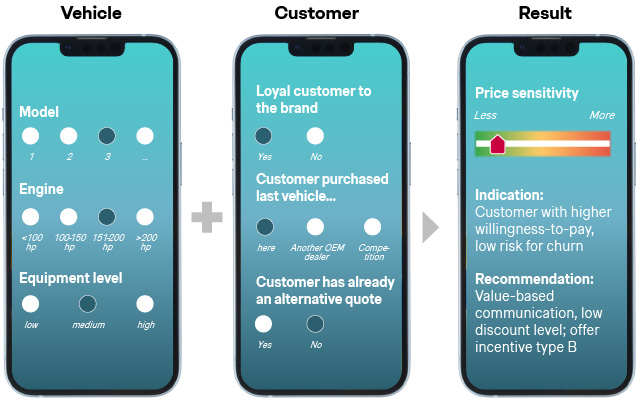
Determine relevant combinations of price levers & incentive elements and make use of tools that support sales at the POS to derive customer-specific prices.
A personalized price recommendation can be used for direct-to-consumer sales and dealer groups or importers. Especially at the point-of-sale, AI-based advanced pricing optimization provides enormous potential to better steer transaction prices and support sales teams across the entire network.
How Simon-Kucher can help
Although these three solutions serve different purposes, our strategy revolves around our extensive experience in pricing and is rooted in reliable data. With a focus on agility and security, the interdisciplinary teams at Simon-Kucher swiftly develop features and deliver high-quality pricing systems customized to meet your requirements.
Considering our expertise in flexible pricing across industries, we propose a crawl, walk, run, fly approach to establish advanced pricing. From data assessment and proof-of-concept to creation and going live with the automated pricing solution, we’ve got you covered. Ready to act and protect margins without jeopardizing volumes? Contact us today.

